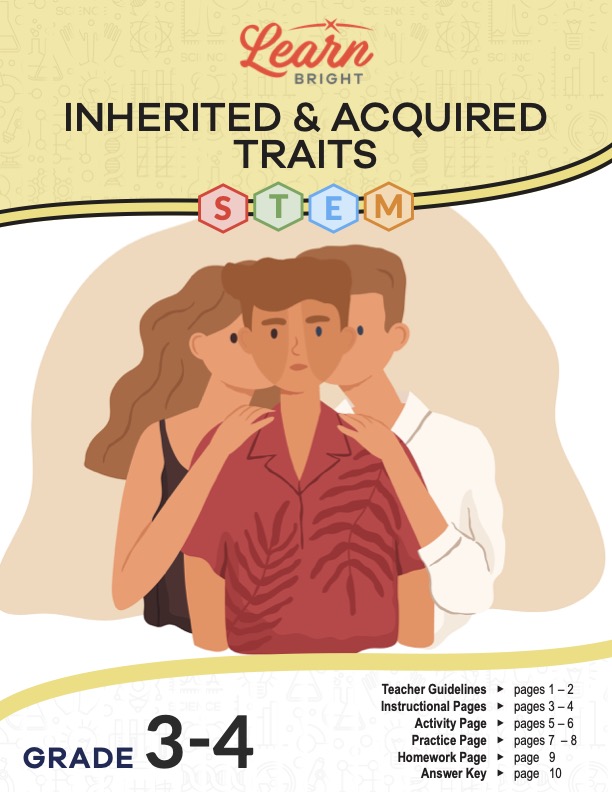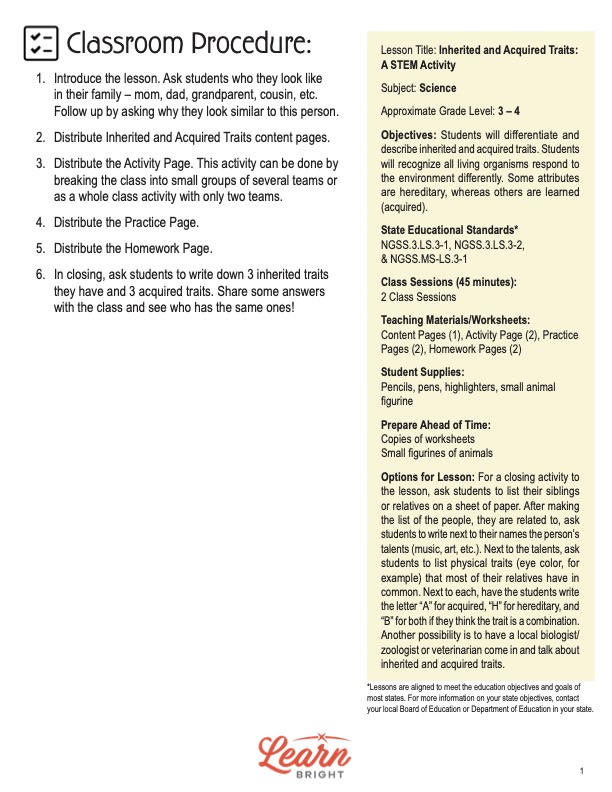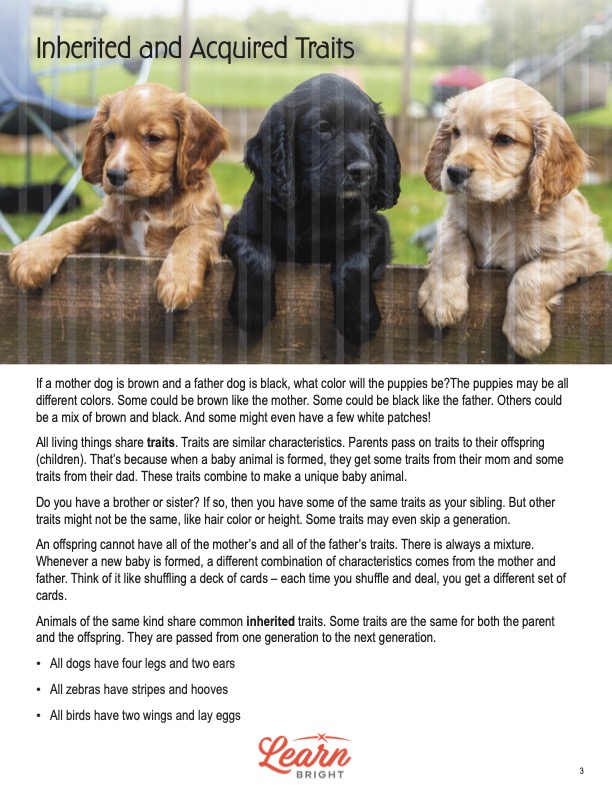Description
What our Inherited and Acquired Traits STEM lesson plan includes
Lesson Objectives and Overview: Inherited and Acquired Traits STEM explores the difference between traits we inherit and those we acquire in life. Students will learn to differentiate between the two types of characteristics. They will also discover that all living organisms respond to their environment differently and thus inherit or acquire different traits. This lesson is for students in 3rd grade and 4th grade.
Classroom Procedure
Every lesson plan provides you with a classroom procedure page that outlines a step-by-step guide to follow. You do not have to follow the guide exactly. The guide helps you organize the lesson and details when to hand out worksheets. It also lists information in the yellow box that you might find useful. You will find the lesson objectives, state standards, and number of class sessions the lesson should take to complete in this area. In addition, it describes the supplies you will need as well as what and how you need to prepare beforehand. This lesson requires pencils, pens, highlighters, and small animal figurines.
Options for Lesson
The “Options for Lesson” section of the classroom procedure page lists a number of suggestions for ideas and activities you could incorporate into the lesson. For a closing activity to the lesson, you could ask students to list their siblings or relatives on a sheet of paper. After making the list of the people they are related to, students can write next to each name that person’s talents. Next to the talents, ask students to list each person’s physical traits (eye color, for example) that most of their relatives have in common. Finally, have the students write the letter “A” for acquired and “H” for hereditary (0r “B” for both if they think the trait is a combination) next to the trait. Another option is to have a local biologist, zoologist, or veterinarian come in and talk about inherited and acquired traits and answer any questions students have.
Teacher Notes
The teacher notes page provides an extra paragraph of information to help guide the lesson and remind you what to focus on. The blank lines on this page are available for you to write out thoughts and ideas you have as you prepare the lesson.
INHERITED AND ACQUIRED TRAITS STEM LESSON PLAN CONTENT PAGES
Inherited Traits
The Inherited and Acquired Traits STEM lesson plan contains two content pages. To start off, the lesson begins by explaining the concept of inherited traits with dogs as the example. If a mother dog is brown and the father dog is black, what color would the puppies be? It’s possible the puppies will be all different colors. Some could be brown like the mother, others black like the father. And still others might have mixed colors or even a few white patches.
All living things share traits. Another name for a trait is a characteristic. Parents pass on traits to their offspring (children) because an offspring inherits some genes from its mother and others from its father. The result is a unique baby animal. Siblings often share some similar traits because they came from the same mother and father. But they don’t have all the same traits, so their hair color or height might be different. Some traits even skip a generation.
An offspring cannot have all the traits of its mother and all the traits of its father. There is always a mixture. Whenever a new baby forms, it receives a different combination of characteristics from the mother and father. The lesson compares this concept to shuffling a deck of cards. Each time someone shuffles and deals, the order of cards is different.
Animals of the same kind share common inherited traits. Some are the same for both the parent and offspring. These traits pass on from one generation to the next. For instance, all dogs have four legs and two ears. All zebras have stripes and hooves. And all birds have two wings and lay eggs.
Acquired Traits
Not all traits come from parents. In other words, an animal will have some characteristics that they did not inherit. Such traits are, instead, acquired. Acquired traits are characteristics that an animal learns in its environment. They can also be created from its environment. For instance, learning to write is not a trait we inherit. A person must learn this skill, so it is acquired.
Similarly, a dog doesn’t know how to shake when it is first born. It has to learn how to do that from the owner. Because the dog learned to shake, the trait is acquired.
The lesson lists a few examples of other acquired traits. Cats have to learn to use a litter box. Dolphins don’t naturally know to jump through hoops but instead learn the trick from a trainer. Humans learn how to fix their hair a certain way. And playing the violin is a learned skill, not an inherited trait.
INHERITED AND ACQUIRED TRAITS STEM LESSON PLAN WORKSHEETS
The Inherited and Acquired Traits STEM lesson plan includes three worksheets: an activity worksheet, a practice worksheet, and a homework assignment. Each one will help students solidify their grasp of the material they learned throughout the lesson. You can refer to the classroom procedure guidelines to know when to hand out each worksheet.
CHARACTERISTICS CARD GAME ACTIVITY WORKSHEET
As the classroom procedure mentions, you can split the class into two teams or into several groups of two teams for the activity. Students will cut out the cards on the second worksheet page and write in two of their own traits. Without looking, you will deal five cards to each team. Team 1 will select a card and has 30 seconds to quietly talk about how to act out the card.
Without saying or mouthing any words, Team 1 will act out the card while Team 2 tries to guess the action or trait. The teams will only get one guess, so they should talk amongst themselves and decide on a final answer before guessing. A correct answer gets one point. Then, if the team can correctly state whether the trait is inherited or acquired, they get another point. The teams then switch back and forth until all the cards have been used. There are two boxes at the bottom of the worksheet to keep track of points.
OBSERVE THE ANIMALS PRACTICE WORKSHEET
For the practice worksheet, you will assign an animal or provide a plastic animal to each students. Students will observe that animal in the wild by watching a video about it. They should consider where the animal lives, what it looks like and sounds like, and so on. Then they will draw and label a picture of their animal in the center circle 0f the worksheet. Finally, they will list an inherited trait in each of the five surrounding circles.
INHERITED AND ACQUIRED TRAITS STEM LESSON PLAN HOMEWORK ASSIGNMENT
The homework assignment requires students to apply what they learned to sort traits as inherited or acquired. There are 12 traits at the bottom of the page. Students will cut out of the pieces and place them under the correct header at the top of the page. Then, they will write three traits they, themselves, inherited and acquired that are not in the list of sorted traits.
Worksheet Answer Keys
If you choose to administer the lesson pages to your students via PDF, you will need to save a new file that omits these pages. Otherwise, you can simply print out the applicable pages and keep these as reference for yourself when grading assignments.









